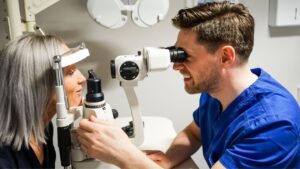What Is SMILE Eye Surgery?
SMILE is a laser eye surgery performed to correct vision impediments like myopia and astigmatism to improve overall vision. SMILE (small incision lenticule extraction) is the most recently developed mainstream laser eye surgery to earn consideration for widespread treatment. Although it is relatively new, over three million people have enjoyed the lasting effects of SMILE as it helps them correct refractive errors.
During a SMILE surgery, the surgeon uses a Visumax femtosecond laser to generate pulses that define and establish an outline of a thin corneal tissue known as a lenticule, learn more about lenticule. The Visumax femtosecond laser is used to make a keyhole incision, typically no more than 3.8 millimetres long, which provides the surgeon access to remove the lenticule. This process reshapes the cornea and corrects or improves patients’ vision.
Is SMILE Surgery Safe?
Small incision lenticule extraction is an invasive, flapless laser surgery that requires an impressively short recovery time of two to four weeks for vision to stabilize completely. Refractive surgeons worldwide have conducted SMILE more than 3 million times with a high success rate and satisfaction rate. It has been performed since 2007, available to the public since 2011, and is conducted in more than 70 countries worldwide. Although all refractive surgical procedures have some inherent risk, SMILE has proven to be a viable and safe refractive eye surgery.

Who Is an Eligible Candidate for SMILE Surgery?
SMILE laser surgery is a good option when the patient has nearsightedness, astigmatism, or a combination of the two. The most eligible candidates for this procedure fit one of the following criteria:
- A severe level of nearsightedness: SMILE eye surgery can be used for vision correction for patients with myopia from -1.00D to -10.00D.
- A propensity for dry eyes: Because the cornea’s incision is minimal, the patient will likely experience fewer sensations of dry eye symptoms.
SMILE reduces your exposure time during the procedure while delivering a perfect vision correction, making it an appealing option for those experiencing either of these conditions. Other variables that may cause a good candidate for SMILE include having a stabilized prescription, average cornea measurements, no prior refractive eye surgeries, and healthy eyes.
By having an eye examination conducted by a surgeon, a patient will get a recommendation on the best procedure for vision correction. The severity of the patient’s refractive error and the thickness and curvature of the cornea should be assessed during this time. Because each refractive laser procedure has its strengths and uses cases, it is essential to use this data and information unique to the patient to determine if the SMILE procedure is correct.
How Do LASIK and SMILE Compare?
LASIK (laser-assisted in-situ keratomileusis) and SMILE are both safe and effective options for laser vision correction. These are similar to laser vision correction procedures in that they correct the patient’s refractive error by reshaping their cornea. However, the method in which the corneal adjustment is achieved differs with each surgery.
LASIK surgery at a Glance
During LASIK surgery, the primary difference is that the surgeon creates a circular corneal flap with a femtosecond laser. After that, he will then establish the corneal flap and raise it. The surgeon will reshape the underlying stroma by removing the corneal tissue for proper vision correction.
When comparing LASIK vs SMILE, LASIK surgery is more versatile because it can correct more refractive errors – including farsightedness (hyperopia). LASIK has become an industry standard for trusted laser vision correction options. It is also super practical, with more than 90 per cent of patients who receive LASIK surgery achieving 20/20 vision (and more than 99% achieving 20/40 vision.
LASIK Surgery Limitations
This procedure has delivered sharp vision free of eyeglasses and contact lenses to countless patients. However, it’s not without some minor drawbacks. The primary negative side-effect of LASIK surgery is the potential sensation of dry eyes, burning, or itching. That results from corneal nerves severed during the flap-creation process in LASIK surgery. Although these sensations disappear within 3 to 12 months, it’s a common symptom for patients in recovery as the nerves grow naturally to cover their initial position. The other minor shortcoming of LASIK surgery is that the creation of the corneal flap will weaken the cornea. For most patients, that is not an issue that factors into their everyday life. However, it’s possible that the flap could dislodge if significant trauma occurs in the eye.

SMILE Surgery Compared to LASIK Surgery
While LASIK and SMILE generate similar results for people with astigmatism, the primary benefit of SMILE is the fact that it’s a flapless laser procedure. SMILE uses a 3.8 mm less invasive keyhole incision. It results in fewer nerves within the cornea being severed during the procedure. That makes dry-eye symptoms much lower for SMILE and allows the SMILE procedure to have a slightly faster recovery time than LASIK.
Since the SMILE procedure leaves the cornea’s outer layers primarily unaffected, the cornea remains solid and stable after the surgery. Interestingly, while LASIK requires using both an excimer laser and a femtosecond laser, SMILE utilizes only the femtosecond laser. Avoiding the flap creation process, SMILE can use one laser to create a piece of corneal tissue with minimal exposure and restricted disruption of the eye’s structural components.
Since the surgeon doesn’t need to create any flap during a SMILE surgery, it may also be a desirable refractive surgery for those with thin corneas. That is because SMILE surgery leaves layers of corneal tissue whole and makes its corrections by removing the necessary layers of the corneal tissue.
SMILE Surgery Limitations
The most notable limitations of SMILE laser eye surgery are the patients it cannot treat. While the SMILE procedure only treats astigmatism and nearsightedness, LASIK and PRK can treat farsightedness plus refractive errors caused by astigmatism, nearsightedness, and some higher-order aberrations.
Moreover, SMILE is a new refractive surgery option. That underscores the importance of due diligence in choosing a surgeon who is experienced and highly recommended to trust with your minor incision lenticule extraction procedure.
Conclusion
Both LASIK and SMILE laser eye surgery and LASIK are proven procedures that can bring better vision to so many people. Each procedure will correct refractive errors by reshaping the cornea; tissue. Both procedures achieve lasting results and have similar visual recovery times. While each surgery has its advantages, patients should consult with refractive surgeons or ophthalmologists to receive a recommendation personalized to their unique refractive error, thin corneas, or other conditions.



